Best Tambourines – Two Basic Parameters to Consider
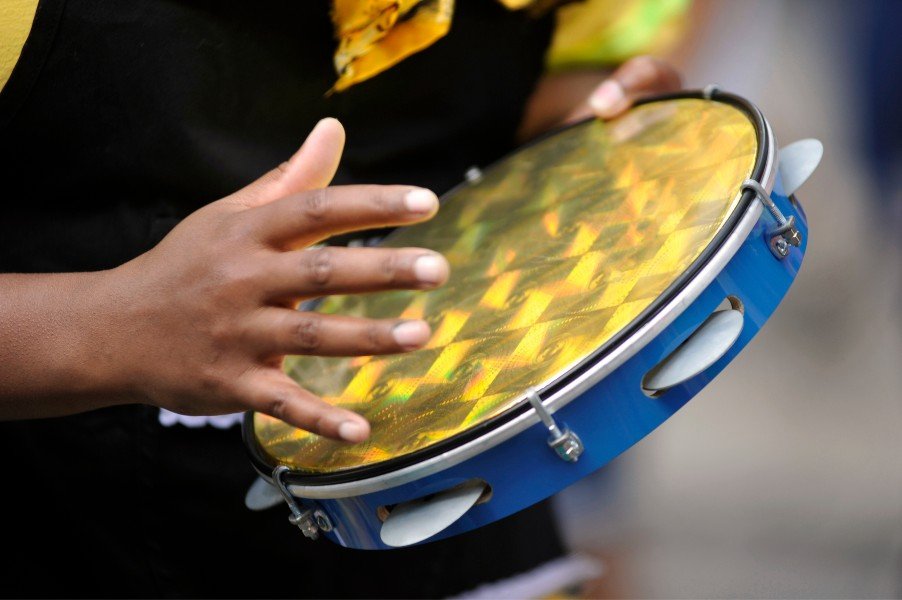
Musfunny tambourine is good for playing music but also, it might be perceived as a well-made toy. It has a 10-inch frame, polyester head, and one round of metal jingles. It is famous for its durability and is usually bought for kids, enthusiasts, and beginners. Musfunny is the best tambourine for various occasions you might want to play some music. If you need a multi-purpose instrument, I’d advise paying attention to the models from this list.
Table could not be displayed.4 Best Tambourine Drum Reviews
Contents
There are various types of tambourines to choose online. And in this article, I will explain the difference between the professional and amateur ones and pay attention to the last ones. They are multipurpose and fit both adults and children, and can suit various occasions.
1. Musfunny 10-inch tambourine: A tambourine drum for any age
No products found.
Musfunny tambourine is a simple instrument whose quality is high enough to suit adult enthusiasts and children who just want to play. This model has 10 inches in diameter and 1.8 inches thick. Such proportions are widespread and fit most people. Musfunny tambourine is also lightweight; it is only bout 6oz. This tambourine’s most important feature is its durability. The frame is made of birch, considered the best wood for drums, and the head is polyester. Such material has one non-obvious advantage: children love to paint it.
There are two crucial features the best tambourines must provide: they have to be comfortable and durable. Suppose you want to use the tambourine as an addition to other instruments and especially play it by hand, test if it fits you by size, proportions, and weight. Musfunny tambourine is about 10 inches in diameter and 2 inches thick, which is typical. Firstly it might seem okay, but remember that some flaws are found only during a full rehearsal. Wrong instruments can make practice annoying, and the tambourine is not an exception.
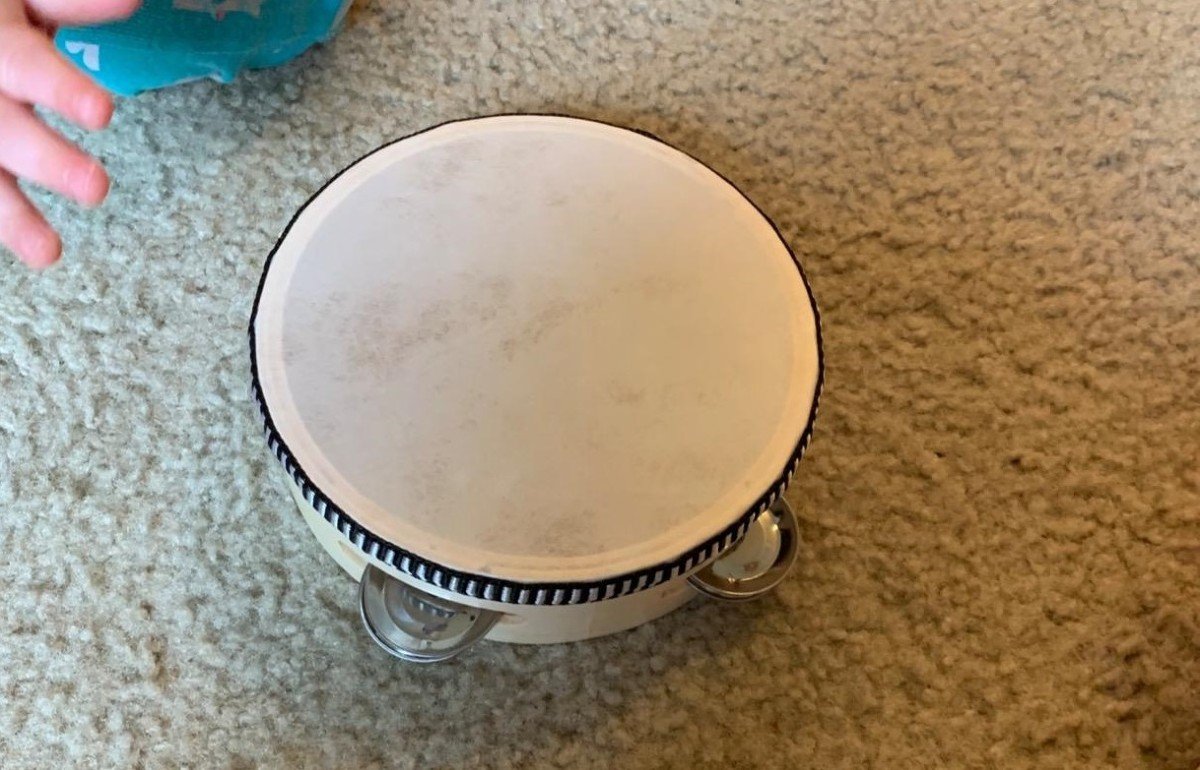
Yet comfort is an individual parameter everyone should consider on their own, and durability is something you’d better check on someone else’s instrument. Musfunny tambourine is designed as a professional instrument and is also popular as a children’s toy. The best way to learn how solid a thing is is to give it to a child, which is exactly what I did. This tambourine has survived almost three months in the hands of my two years old nephew. I count it as a good result, meaning Musfunny tambourine can serve you for years if you don’t crush it intentionally.
Musfunny tambourine is a universal instrument. Firstly, it was intended for adults and kids. So, it can be used both as a toy by kids and as a professional or amateur instrument at a party or church. Secondly, this model has typical proportions and thus might fit almost any hand. I would call it the main advantage.
The materials it is made of are trustworthy: metal and wood. The birch frame is definitely more robust than the plastic one. Metal jingles give a sonorous sound, just like a classical tambourine should provide. The only thing that can be a problem for professional musicians is the head because the sound polyester gives is not the best. Natural leather always sounds much better than any synthetic material.
- Durable frame is made of birch;
- Comfortable proportions;
- Fits both children and adults.
- Polyester head might disappoint professional musicians.
2. Dreokee 8-inch tambourine: A well-made tambourine for learning
No products found.
Dreokee tambourine is a classical tambourine that slightly differs from professional ones. Yet, it is made well enough to fit beginners. At first glance, the Dreokee tambourine looks like the Musfunny, yet if you take a closer look, you notice a difference in the proportions. Although two inches may seem insignificant, a tambourine must be comfortable to hold, and such details matter in the long run. If you are looking for an instrument to play music, keep in mind that rehearsals might last for hours, and an unsuitable instrument in your hand can be very annoying.
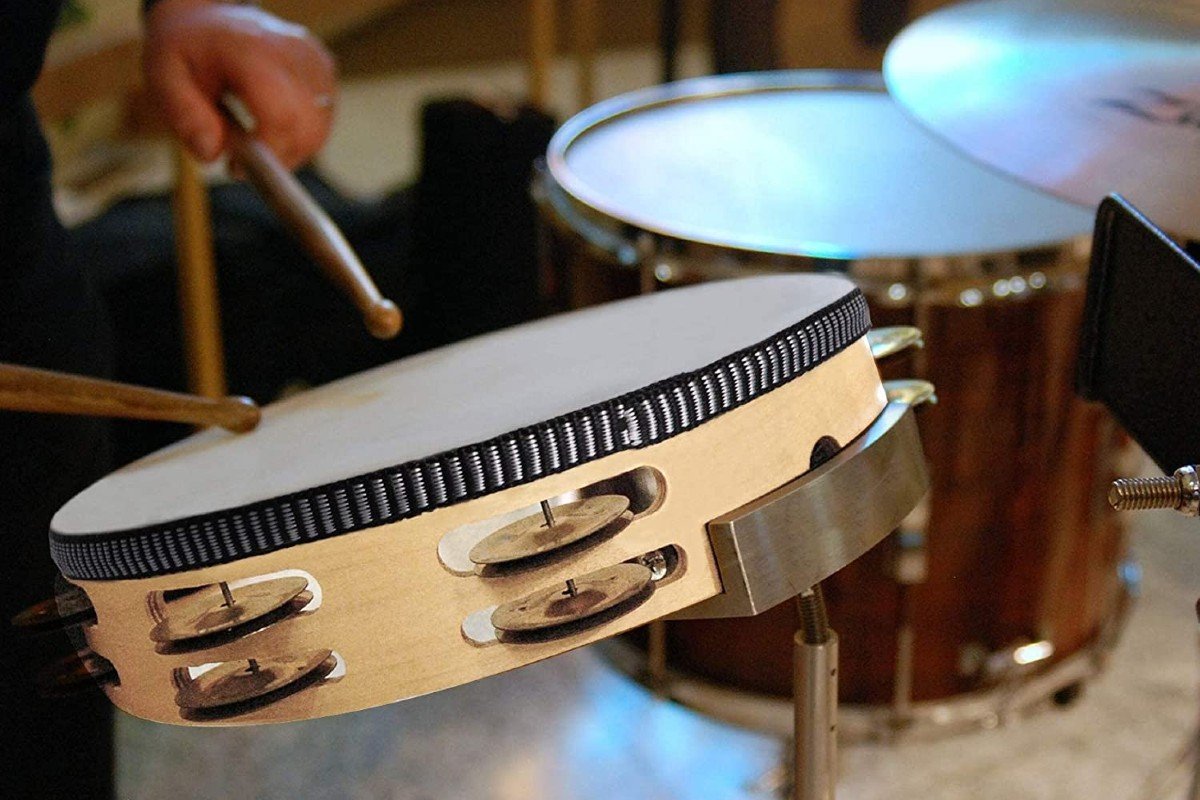
Dreokee tambourine is made of birch, which means the frame is durable, this type of wood is also thought to give the best sounding to the drums. Unlike concert tambourines, Dreokee tambourine has one row of jingles, but there is one feature that makes this instrument more professional than Musfunny. Dreokee tambourine has a natural sheepskin head that gives a better sound than such synthetic materials as polyester. However, one row of jingles is not a flaw. They still give loud and bright sounds.
- Solid wooden frame;
- Natural sheepskin head;
- Bright jingles.
- The head might be loose.
3. LP174: The best tambourine for drum kit
No products found.
LP174 differs from all the tambourines I mention in this list because it doesn’t look like a classical instrument. The classical instrument is made of wood and has a skinhead and two rows of jingles. LP174 is fully made of steel, and it has no head. It has a soft, convenient handle, therefore, it fits both people with small and big hands. This might not be the best tambourine for church since parishes prefer classical models, yet LP174 fits any other occasion like a party, play, or even rehearsal. Moreover, LP174 is a good addition to the drum kit. Since it has no top, you can put this tambourine on the cymbals and play it not only with your hands but also with the sticks.
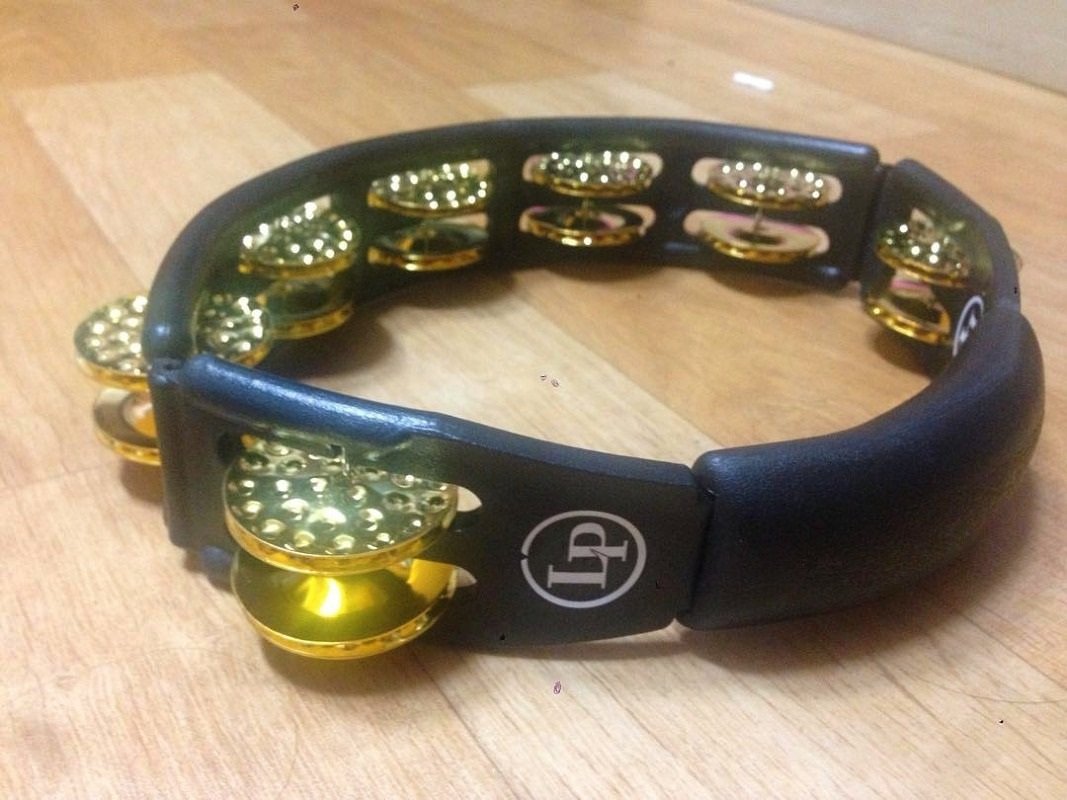
I like this tambourine for the unusual sound it gives. This model has nickel-plated gingles that create warm and cutting sounds simultaneously. Two rows of jingles always make the sound more variable than one does, especially when combined with the steel frame.
- Strong steel frame;
- Both warm and cutting sound;
- Fits drum kit due to the construction.
- Handle might wear out over time.
4. Eastar Tambourine: Best tambourine for church
No products found.
Eastar Tambourine is the closest to the concert type. The frame is made of wood, it has two rows of jingles, and unlike most tambourines, they are made of stainless iron instead of aluminum, providing a more precise sound. Natural goat skin also improves the sound, the beat sound deeper, yet it is less durable than polyester and might sound unpredictable outdoors when the weather changes. The skin is fixed on the drum with 17 rivets and strong glue, so it won’t lose over time.
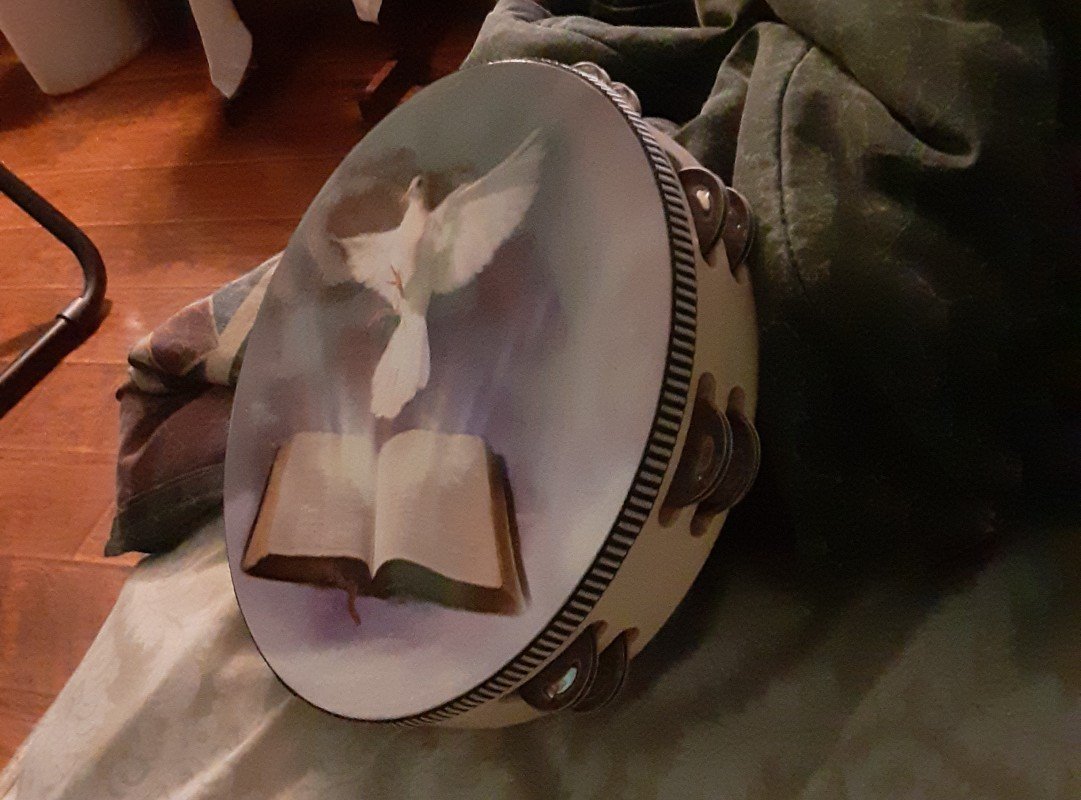
Among other tambourines, Eastar Tambourine fits best performances, so if you are going to play it in front of people, for example, at a concert or in church, this instrument meets your needs.
- Crisp sound due to stainless iron jingles give;
- Natural skin;
- Two jingle rows.
- The skin might seem too thin.
Tambourine Buying Guide
What is a tambourine, and where does it comes from
The tambourine is a musical instrument with simple construction and long history. It belongs to a percussion family, and it is constructed of a wooden or plastic frame and little metal jingles. Tambourines usually have a drumhead, but not always. Due to such a construction, it can be played in a few different ways and found in several cultures and genres. This instrument can be a part of a drum set and played with drumsticks or held in hand and played by hitting and shaking.
The word tambourine probably comes from the Arabic word “tunbur,” which stands for drum. Despite the eastern origin of the name, tambourine has a lot of analogs all over the world. For example, in India, such an instrument is called kanjira, Israelites call it timbrel, and in Ukraine, they use the word bubon. This instrument is ancient; it appeared approximately about 1700 BC, the same time when the last wooly mammoth went extinct and Knoss was destroyed by fire. To compare, a piano, as we know it today, appeared only in the 17th century. In the 19th century, composers like Chaikovskii and Bizet started to use this instrument in their works. In the 20th century, the tambourine became popular among musicians of various genres, including gospel.
How to choose a good tambourine for you
Due to the simple construction, the tambourine is not the kind of instrument that you can tune and get different notes. It has a secondary role in helping to keep the beat or diversifying the sounding. As this instrument doesn’t have many characteristics, choosing the right one becomes quite easy.
- First and foremost, it must be light and comfortable to hold in hand. Even if you have a clear plan to put it in the drummer kit and play with sticks, plans change. Once you need to play by hand, you won’t waste time on the new one. Practice and rehearsals take a lot of time, and an unsuitable instrument might become another problem you could avoid.
- As an instrument that always gets hit, the tambourine should also be durable. You may not notice how it wears out, but it becomes a little bit shabby every time you play. Pay attention to the material it is made of, the joints’ robustness, and the skin’s quality, if any.
- Yet tambourine isn’t that simple; there is still a chance to choose what kind of sound you want to get. It depends on the shape, size, skin, and kind of jingles. Standard tambourines have one type of jingles, but there are models with two different jingles nearby, which make the sound richer.
FAQ on Tambourine Drums
However simple a tambourine might seem, there are always some nuances about any musical instrument. Here are some facts to learn before buying and playing it.
What types of tambourines are there?
The tambourine is an ancient instrument that can be found almost all over the world. There are lots of different types of tambourines, with lots of different names and construction variations, but for now, there are five the most common types:
- Single-row tambourine, which has only one round of jingles, is a bare minimum.
- Double-row tambourine has two rounds of jingles. It is louder and exists in a number of variations, as a pair of two jingles that differ by size and thickness of the material makes different sounds.
- The concert tambourine is covered with skin and has two rounds of jingles.
- The hi-hat tambourine is a part of the drum set attached to the top of the cymbals.
- A foot tambourine is a kind of tambourine that is played by foot.
Are tambourines tuned?
As drums have no pegs, you might think they aren’t pitched instruments, which is not actually true. You can tune any drum to play different notes by tightening the head as the drum skin sounds higher or lower depending on how strong the tension is.
However, tambourine rarely gets tuned; there is just no need to do it. The main source of the sound is jingles, not skin, and you beat the head not to get a particular note. That is why the tambourine is considered a secondary instrument, intended to brighten the sound of the whole composition rather than keeping the melody.
How to hold a tambourine?
The first thing you learn about any instrument is how to hold it, and no matter how simple a tambourine may seem, this rule applies to it too. Tambourine has three parts: the head (a part covered with skin), the shell or the frame, and the jingles. When you are ready to play, take your tambourine with your non-dominant hand and rotate it to 45 degrees toward the floor. The sound depends much on an angle. You can set your own experiments and see how jingles work in different positions. If you hold the tambourine close to a vertical position, the jingles slide too much, and the sound isn’t clear enough. Yet if the position is too close to vertical, the jungles fall right after you tap and also give no proper sound.
Cool Tambourine drums for Children and Adults
It depends on your expectations which tambourine is good for you. Tamborine can play a few roles and can be played in many different ways. There are tambourines with and without heads, with different numbers of jingle rows and different kinds o jingles. Only two rules relate to all types of tambourines: they must be comfortable to play by hand for a long time, and they must be durable. Other parameters should be relevant to your goals. Musfunny tambourine proved its durability in practice, serving as a child toy for three months. It also has a handy shape and solid materials.
For which purposes are you choosing a tambourine, and which parameters are crucial for you? Please, share in the comments.




